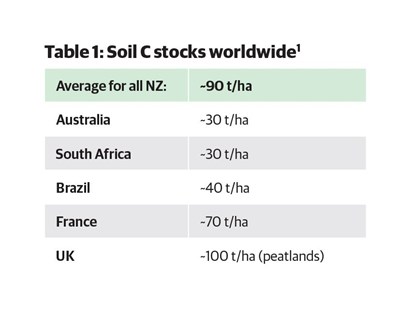Monday, 9 August 2021
New Zealand’s carbon soil stocks: what do we know?

New Zealand has on average 90 tonnes per hectare of carbon (C) stored in its soils, which by world standards is high (Table 1 opposite). Manaaki Whenua – Landcare Research soil scientist and research area leader Dr Paul Mudge discusses why soil carbon stocks are important and where we sit on the world spectrum when it comes to the carbon levels in our soils.
Soil organic carbon is critical for overall soil health, and because soils contain more than twice as much carbon as the atmosphere, any increase or decrease will impact atmospheric CO2 concentrations and therefore climate. Carbon continuously cycles in soil, so stocks can change over relatively short time scales in response to changes in land use and management (and changes in temperature and precipitation regimes).
Soil carbon has important functions, such as:
- Maintenance of soil structural stability which influences root growth, air and water movement and therefore runoff and erosion
- Water retention
- Food source for soil biota
- Nutrient storage and cycling.
In general, losses of carbon can occur faster than gains. Concern over climate change is prompting nations, organisations and individuals to implement actions to curb greenhouse gas (GHG) emissions and sequester carbon above and below ground.

Soil C stocks to 30cm depth
In general, New Zealand has lots of soil carbon and we want to maintain or increase (where possible) the amount of carbon in our soils.
There are several reasons why New Zealand soils contain large amounts of carbon:
- Our soils are geologically young and human settlement has occurred comparatively recently.
- Our soils have generally been well managed with little intensive tillage and cropping practices that have decreased soil carbon in many other countries.
- Most of our pastures are long-term perennial, meaning soils are rarely devoid of growing plants.
- New Zealand has a temperate climate that mostly supports year-round plant growth, resulting in continuous inputs of carbon into our soils from plants.
- The chemical and physical properties of our soils mean they generally have a large capacity to protect carbon from loss.
- A large proportion of our pastures are grazed by livestock, which recycle carbon in the form of dung.
From this high starting point, it’s considerably harder to add to New Zealand’s soil carbon stocks than in other countries where more challenging environmental conditions and/or long-term intensive cropping have resulted in low baseline soil carbon stocks.
Changes in New Zealand soil carbon stocks
It’s highly uncertain whether soil carbon stocks across all of New Zealand’s managed pastures are increasing, decreasing or stable. Current evidence suggests that:
- For grazed pastures on flat-to-rolling land, soil carbon stocks in most soils did not change between about 1980 and 2010.
- Allophanic and Gley soils have previously lost carbon, but it’s not known whether losses are ongoing.
- Drained peat soils continue to lose carbon at quite high rates.
- Some hill country grassland soils (which occupy about 4 million hectares or 38% of New Zealand’s grazed land) gained carbon at a rate of up to 0.6t/ha/year between 1980 and 2010. However, it isn’t clear how widespread these gains were or whether they’re ongoing.
More spatially and temporally comprehensive data are needed to better determine soil carbon trends in different physical environments, land uses and management practices. Ongoing research and benchmarking/monitoring programmes2 will provide some of these data.
The impact of soil erosion is important to consider. Erosion redistributes topsoil (and any carbon it contains) around the landscape. Some carbon is buried and stabilised (for example at depth in the soil, or in lake and ocean sediments) and some is decomposed. Research by Manaaki Whenua has found that soil carbon stocks on uneroded soils average around 100t/ha but only 60–65t/ha on sites with extensive landslide and gully erosion. Soil carbon stocks do build back up again in eroded sites, however not to the same extent as uneroded sites. Research is ongoing to understand the effect of human-induced erosion on net carbon dioxide emissions from soils.
Right now, New Zealand pasture soils generally have high stocks that seem stable under contemporary management practices. But there’s a lack of scientific evidence about practices that increase soil carbon.
Because of the uncertainty around how New Zealand’s soil carbon stocks are changing within any land use, and how changes are influenced by specific management practices, New Zealand’s national greenhouse gas inventory does not currently account for changes in soil stocks within a land use. Reporting is limited to accounting for soil carbon stock changes when land use is changed, for example from arable to pasture. You can read more about this type of soil carbon accounting on the Landcare Research website 2, Ministry for the Environment website3 and the AgMatters website.4

